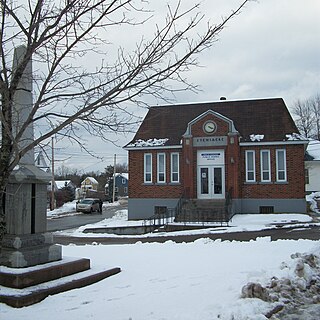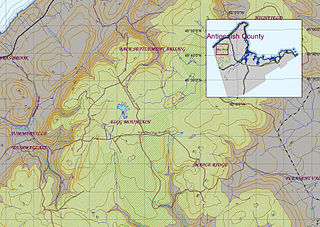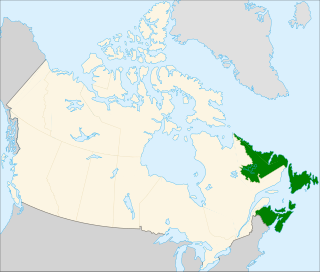
Stewiacke is a town located in southern Colchester County, Nova Scotia, Canada. The town was incorporated on August 30, 1906.

Bedford is a current community of the Halifax Regional Municipality, in Nova Scotia, Canada.

Halifax Harbour is a large natural harbour on the Atlantic coast of Nova Scotia, Canada, located in the Halifax Regional Municipality. Halifax largely owes its existence to the harbour, being one of the largest and deepest ice-free natural harbours in the world. Before Confederation it was one of the most important commercial ports on the Atlantic seaboard. In 1917, it was the site of the world's largest man-made accidental explosion, when the SS Mont-Blanc blew up in the Halifax Explosion of December 6.

Burnside is a Canadian urban neighbourhood located along the northeast shore of Bedford Basin of the Halifax Regional Municipality in Dartmouth, Nova Scotia.

Dartmouth Crossing is a commercial real estate development in Dartmouth, a part of Halifax Regional Municipality, Nova Scotia, Canada.

The Green Party of Nova Scotia is a green political party in the Canadian province of Nova Scotia. It received official party status in the province in April 2006. The party has not won any seats in the Nova Scotia House of Assembly.

Theodore Tugboat is a Canadian children's television series about a tugboat named Theodore who lives in the Big Harbour with all of his friends. The show originated in Halifax, Nova Scotia, Canada as a co-production between the CBC, and the now defunct Cochran Entertainment, and was filmed on a model set using radio controlled tugboats, ships, and machinery. Production of the show ended in 2001, and its distribution rights were later sold to Classic Media. The show premiered in Canada on CBC Television, then went to PBS, was on Qubo in the United States, and has appeared in eighty different countries.

Scouting in Nova Scotia has a long history, from the 1900s to the present day, serving thousands of youth in programs that suit the environment in which they live.

Citadel High School is a high school in Halifax, Nova Scotia, Canada.
In Canada, the criminal legal system is divided into federal and provincial/territorial jurisdictions. Provincial/territorial correctional services are only concerned with offenders who have been sentenced for less than two years, whereas federal corrections—facilitated by Corrections Canada—is concerned with offenders who have been sentenced for two years or more.
David G. Coles, is a Canadian lawyer. He received his B.A. from Dalhousie University in 1981. He then received his LL.B. in 1984, also from Dalhousie. He was admitted to the Nova Scotia Bar in 1985.
Boisdale is a community in the Canadian province of Nova Scotia, located in the Cape Breton Regional Municipality on Cape Breton Island. It was named for Lochboisdale, the main village of the island of South Uist in the Outer Hebrides of Scotland. Neil Campbell was granted land in the area in 1836. In 1821, Thomas Lockman, an Irishman who came to Cape Breton in 1799 and lived at Lloyds Cove, petitioned for land, and got a grant next to Neil Campbell's lot in 1842. Angus McIntyre got a grant in 1846, and in 1869, land at what was then called Boisdale was granted to Dugald O'Henley. Farming and lumbering were the basic industries. In 1840, a small log church was constructed by Father John Grant on where the present-day church resides. It was replaced by a new building in 1862, which burned down in September 1928. In 1846, Boisdale Parish was officially erected. A post office was established at Boisdale Chapel in 1854. On October 1, 1873 a new post office was established with Michael McIntyre as office keeper. In 1874, the total population of Boisdale, was that of 500. During this time, the area had 1 store, 3 sawmills, 1 grist mill, and a post office, of which mail was delivered bi-weekly. By 1908, it contained 1 hotel, 2 general stores, 1 saw mill, and 2 gristmills. The population at that time, was 300. In 1915, a newer 40,000 gallon open-wood tank was built replacing an older 40,000 gallon wood tank, for the water services within the area. Father Alexander F. MacGillivray, whom was the fifth pastor of Boisdale, had installed the bell within St. Andrew's Church in Boisdale, in 1882, and had built the Glebe house there in 1890. A new and larger bell, cast by the Meneely Bell Company of New York, was installed in St. Andrew's Church, by Father MacGillivray, on Nov. 14, 1897. In 1921, Father Gillis built St. Andrew's Parish Hall, James Johnston of Red Islands, Nova Scotia was the contractor. The formal opening of the hall was held on September 13, 1921. The original St. Andrew's Parish Church was destroyed by fire on Sunday, September 11, 1927. Construction of a new stone church commenced in June 1929, with help from workers from Quebec. The design style of the church was inspired by the Norman architecture as well as the St Mary the Virgin, Iffley church in England. Link, Weber, and Bowers, architects hailing from Pittsburgh, Pennsylvania, designed the architecture of the church. The approximate cost of the church was $55,000, but the exterior walls had to be repointed during the summer of 1930, which added an extra $7,500 to the total cost. The new church was blessed on Sunday, August 31, 1930, by Bishop James Morrison, assisted by the late Bishop Alexander MacDonald. In 1931, the total population of Boisdale was 449. There was also a train station located on Station Road, in Boisdale during this time. The former Glebe House for St. Andrew's Church was burnt down in 2011, due to a fire. Dugald Smith was the teacher in 1839, and a school-house had been constructed by that time. A new school-house was completed in 1917. Education within the area dates back to the early 1800s, with the Boisdale Consolidated School closing in 2003. The enrolment for the school, in the 1957–1958 academic year, were 82 students, and 3 teachers. By the 1987 Academic year, there were only 21 students, all within grades primary-second, and fourth. In 1943, within what is now known as Ironville, then known as Boisdale Barrachois until 1907, a youth summer camp was built. The two-week summer camp operated from 1943, until its closure in the 1980s. Efforts were made in 1997 to re-open the camp in the spring of 1998. The camp officially closed in 2010, due to the deterioration of some of the buildings. The property in which the youth camp was on, was sold in 2013. In August 1977, the community of Boisdale, as well as Father Webb, unveiled and held a ceremony for the opening of an indoor stone, ice-skating rink. Father Webb also built a Co-op store, in the 70s. A new hall above the store replaced the old Holyrood Hall, which burned down on December 18, 1975. By 1956, the population of Boisdale was 133. Over the years the population decreased, down to 138 by 1991, and estimated to be 105 by the 2001 Census.To the Hill of Boisdale,a book on the genealogical history of Boisdale was published in 1986, and later in a revised edition in 2001, by Father Allan MacMillan, then Priest of the Diocese of Antigonish. Highland Gold Maple, a family-owned and operated sugar maple producer, has been operating within the area for over fifteen years. In late April 2018, their operation burned to the ground due to a fire. By March 2019, Highland Gold Maple had rebuilt the Sugar Shack and are back in operation.

Andrew Younger is a Canadian politician and journalist, first elected to the Nova Scotia House of Assembly in the 2009. He represented the district of Dartmouth East first as a member of the Nova Scotia Liberal Party and subsequently as an Independent. In 2015, Younger was removed from cabinet and the Liberal caucus after invoking parliamentary privilege in order to avoid giving testimony at a criminal trial.

Ralph Jordon Croucher, better known by his stage name JRDN, is a Canadian R&B recording artist.
Nova Institution for Women is a Canadian federal prison for women in Truro, Nova Scotia. The facility, which handles different levels of offenders, can accommodate up to 70 inmates. Nova Institution opened in 1995. The maximum security unit opened in 2002 or 2003.

Timothy Jerome Houston is a Canadian politician who is the 30th and current premier of Nova Scotia since 2021. He was first elected to the Nova Scotia House of Assembly in the 2013 provincial election. A member of the Progressive Conservative Party of Nova Scotia, he represents the electoral district of Pictou East. Houston also served as the leader of the opposition from 2018 to 2021. He and the Progressive Conservative party won a majority government in the 2021 Nova Scotia general election, becoming the first Progressive Conservative premier since 2009.

In prison terminology a dry cell is a room that prisoners are placed in that lacks any plumbing facilities such as a toilet or shower. In the Federal Bureau of Prisons, a dry cell can be used if a prisoner claims to be unable to urinate for a drug test under direct visual supervision. Prisoners are also sometimes placed in dry cells if they are suspected of having swallowed contraband. The idea is that they will eventually excrete all the contents of their digestive system, and lacking any toilet, they will be unable to dispose of it and thereby prevent prison officials from acquiring the evidence.

Eigg Mountain is high plateau, part of the highlands of Antigonish County, Nova Scotia, Canada.

The Atlantic Bubble was a special travel-restricted area created on July 3, 2020, during the COVID-19 pandemic in Canada. The area was an agreement between the four Atlantic Canadian provinces of New Brunswick, Prince Edward Island, Nova Scotia, and Newfoundland and Labrador which allowed unrestricted travel among provincial residents and restricts travel from Canadians who are residents of outside provinces. Residents wishing to travel to the Atlantic Bubble are subjected to screening and are required to quarantine for 14 days before moving freely throughout the bubble. Individual provinces have specific rules toward travellers from outside of Atlantic Canada. The provinces in the bubble have seen the lowest numbers of COVID-19 compared to other Canadian provinces throughout the pandemic.
















